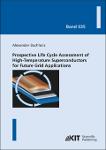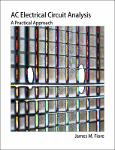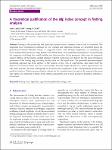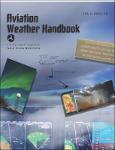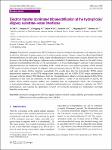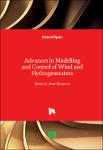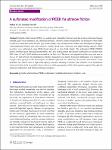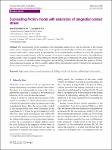Search
Author
- Amir, Ebrahimi (2)
- Aydin, Azizi (2)
- George, Haller (2)
- James, M. Fiore (2)
- next >
Subject
- robotics (9)
- Engineering (8)
- engineering (8)
- công nghệ (3)
- next >
Date issued
- 2020 - 2023 (215)
- 2010 - 2019 (28)
- 2001 - 2009 (6)
Has File(s)
- true (249)
Search Results
A new type of lubricating material (BTA-P4444-Lig) was synthesized by combining lignin with tetrabutylphosphorus and benzotriazole. The tribological properties, corrosion resistance, and anti-oxidation properties of BTA-P4444-Lig as a lubricant were investigated. The lubricating material exhibits excellent friction reduction and wear resistance, as well as good thermal stability and excellent oxidation resistance. Mechanistic analysis reveals that the active elements N and P in the lubricating material react with the metal substrate, and the reaction film effectively blocks direct contact between the friction pairs, affording excellent friction reduction and wear resistance. At the same time, the phenolic hydroxyl group in lignin reacts with oxygen free radicals to form a resonance-... |
High-temperature superconductors have distinct advantages compared to conventional conductors. Below their critical temperature, superconductors have immeasurably low ohmic losses. To maintain the superconducting state, superconductors require constant cooling. This study aims at identifying the environmental impacts of the application of superconductors in future grid technologies such as superconducting power cables. |
The last decade has witnessed a surge of interest in artificial neural network in many different areas of scientific research. Despite the rapid expansion in the application of neural networks, few efforts have been carried out to introduce such a powerful tool into lubrication studies. Thus, this work aims to apply the physics-informed neural network (PINN) to the hydrodynamic lubrication analysis. The 2D Reynolds equation is solved. The PINN is a meshless method and does not require big data for network training compared with classical methods. Our results are consistent with those obtained by experiments and the finite element method. Hence, we envision that the PINN method will have great application potential in lubrication and bearing research. |
This text is based on the earlier Workbook for AC Electrical Circuits, which it replaces. The original expository text has been greatly expanded and includes many examples along with computer simulations. For the convenience of those who used the Workbook, many of the problem sets are the same, with some re-ordering depending on the chapter. |
Fretting in the partial-slip and gross-slip regimes under a constant normal load is considered. The tangential force—displacement relations for the forward and backward motions are described based the generalized Cattaneo—Mindlin theory of tangential contact and Masing’s hypothesis on modelling the force—displacement hysteretic loop. Besides the critical force and displacement parameters (characterizing the triggering of sliding), the model includes one dimensionless fitting parameter that tunes the tangential contact stiffness of the friction—contact interface. Explicit expressions are derived for the main tribological parameters of the fretting loop, including the slip index and the signal index. |
This handbook describes the United States (U.S.) aviation weather program, products, and services. It also documents weather theory and its application to aviation. The objective of this handbook is to help the pilot and operator understand the basics of weather, aviation weather hazards, and aviation weather products. The information included is not prescriptive. Furthermore, the guidance and recommendations in this handbook are not legally binding in their own right and will not be relied upon by the FAA as a separate basis for affirmative enforcement action or other administrative penalty. Conformity with the guidance and recommendations is voluntary only and nonconformity will not affect rights and obligations under existing statutes and regulations. |
Triboelectric nanogenerator (TENG) based on triboelectrification has attracted wide attention due to its effective utilization of green energy sources such as marine energy. However, researches about liquid-liquid triboelectrification are still scanty as solid—liquid triboelectrification has been widely studied. Herein, this work focuses on the hydrophobic/slippery substrate—water interfacial triboelectrification based on the solid friction materials of polytetrafluoroethylene (PTFE) nanoparticles. The hydrophobic/slippery substrate—water interfacial triboelectrification are studied by assembling PTFE coated Al sheets and perfluoropolyether (PFPE) infused PTFE coated Al sheets (formed the slippery lubricant-infused surfaces (SLIPSs)) as the friction electrode, and water as liquid fr... |
Rapid deployment of wind and solar energy generation is going to result in a series of new problems with regards to the reliability of our electrical grid in terms of outages, cost, and life-time, forcing us to promptly deal with the challenging restructuring of our energy systems. Increased penetration of fluctuating renewable energy resources is a challenge for the electrical grid. Proposing solutions to deal with this problem also impacts the functionality of large generators. The power electronic generator interactions, multi-domain modelling, and reliable monitoring systems are examples of new challenges in this field. This book presents some new modelling methods and technologies for renewable energy generators including wind, ocean, and hydropower systems. |
Polyether ether ketone (PEEK) is a widely used material for friction pairs due to its excellent mechanical strength, good wear resistance, and chemical inertness. However, some modifications are necessary when PEEK is used as a water-lubricated friction pair. In this study, a novel sulfonation method was developed to design a water-lubricated friction pair with ultralow friction, good wear resistance, and high loading capacity. PEEK powders were sulfonated using ClSO3H and sintered to form bulk plastic. The sulfonated PEEK (SPEEK) plastic exhibited good tribological properties. At a low sliding speed, the friction coefficient was smaller than 0.02 when a 3 wt% NaCl solution was used as the lubricant. The order of magnitude of the wear rate was as low as 10−8 mm3/(N·m). |
The incorporation of the saturation of the tangential contact stress with the increase of the normal contact stress is required for the analysis of the friction phenomenon of solids and structures subjected to a high normal contact stress, which cannot be described by the Coulomb friction condition, in which the tangential contact stress increases linearly with the increase of the normal contact stress. In this article, the subloading-friction model, which is capable of describing the smooth elastic—plastic transition, the static—kinetic transition, and the recovery of the static friction during the cease of sliding, is extended to describe this property. Further, some numerical examples are shown, and the validity of the present model will be verified by the simulation of the test ... |


